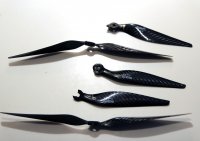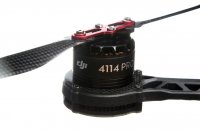I wouldnt argue that there are additional sources of vibrations from airflow but I dont think telling people to NOT balance is the right thing. You should check each and every prop on a good balancer and make sure it is at least close. Plus, with the exception of props with massive hubs like APC thins or wood Xoars, you only have to put some tape on the light blade and not worry about hub balancing.
I didn't really tell people not to balance props. I just said it's "almost pointless". I don't bother, but I didn't tell other people not to. The key thing here is that if your vibration management strategy is to ignore vibration damping, and balance your props to the nth degree so you don't have jello in a hover, you're still going to have problems soon as the aircraft starts moving through the air. And that moving through the air could even include just holding position in a breeze. And the data seems to be showing that if your vibration damping system can handle the vibration from air movement, then it can also handle the vibration from moderately unbalanced props.
Even a glider..... a plane without a motor.... can be pushed to reach a descent speed that allows the airframe to begin to severely vibrate.....
This is called the airframe's resonant frequency which typically starts on the wings or tail section.
if allowed to continue too long at this critical speed, the airframe will begin to disintegrate as the amplitude of the resonant frequency increases.
This is sometimes referred to as a "destructive sinusoidal wave".
In the case of a Multirotor, this can even occur with perfectly balanced motors and props and can first occur in the MR airframe or in the props especially if the props are too flexible.
Propellers made from more than one material such as cork center material wrapped in carbon fiber have built-in vibration dampening characteristics which tends to help especially in the acoustical range.
Analyzing this is possible with the right data and formulas but is much simpler with Comsol Multiphysics software......assuming you have the $$$$ as well as the training to use it!!!
For Multirotors designed to carry cinema quality cameras, and typically fly at relatively slow speeds, it is less likely that there will be issues of this kind occurring except when attempting to penetrate very strong winds.:tennis:
I do not disagree that the effect you are talking about does occur on fixed wing aircraft. But it has *nothing* to do with the problem on multirotors. It's a completely separate issue.
The problem is airflow entering the prop-disk at an oblique angle has a component which is tangential to the rotor disk (ie: sideways into the prop). This creates a higher amount of lift on the advancing blade, and lower lift on the retreating blade. This creates a torque trying to twist the propeller. But, the torque is sinusoidal, because when the propeller has rotated around and is parallel to the tangential airflow, the torque disappears, and then reappears again 90° later. It's a sinusoidal torque vibration.
This is an issue on helicopters too, which is why helicopters invented flapping rotor heads. The flapping alleviates the differential lift, and thus the vibration. But multirotors do not have flapping blades. So, you get this vibration. I expect the vibration is worse with stiffer propellers. And it should be worse with larger, slower turning propellers.
This vibration occurs well, well below the VNE of the aircraft.
And it just kind of hit me now that this might be EXACTLY what is causing these CF props to fail. They're very stiff, and under quite a lot of vibratory stress in flight. It's fracturing them.



